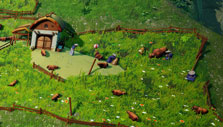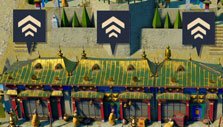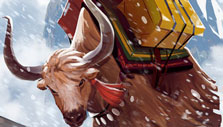Laysara: Summit Kingdom
 by Aethyna
Apr 22, 2024 |
1
Votes |
98
Played |
0
Reviews
by Aethyna
Apr 22, 2024 |
1
Votes |
98
Played |
0
Reviews
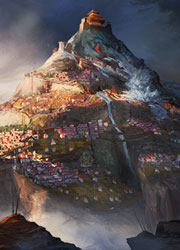 8
rate
Laysara: Summit Kingdom is a unique city-building game where the goal is to build your way to the top of the hill to appease the Spirits and hope they will dispel the mysterious mist that blanketed the valley where the Kingdom lies. Will you be able to save the Kingdom from the mist?
Play Now
Similar Games
Played
8
rate
Laysara: Summit Kingdom is a unique city-building game where the goal is to build your way to the top of the hill to appease the Spirits and hope they will dispel the mysterious mist that blanketed the valley where the Kingdom lies. Will you be able to save the Kingdom from the mist?
Play Now
Similar Games
Played
People Also Played







Summary
Laysara: Summit Kingdom is a unique city-building game where the goal is to build your way to the top of the hill so as to appease the Spirits and hope they will dispel the mysterious mist that blanketed the valley where the Kingdom lies. Will you be able to save the Kingdom from the mist?
Plotline
A mysterious mist made its way into the Kingdom, blanketing the area following a harvest. Crops started to fail, disoriented animals didn’t produce any milk, and people were getting ill.
The kingdom has sent out a team of pioneers to travel through the forests and reach the mountains where they are to build their way to the top. The goal here is to build a grand altar at the summit so as to appease the Spirits and enlist their help in dispelling the mist.
However, the journey to the top isn’t easy, especially with the increasingly infertile land as you make your way up and the occasional avalanche that will bulldoze everything in its way. Will you be able to make it?
Gameplay
Laysara: Summit Kingdom isn’t your typical city builder. Right from the start, you’ll get the idea that the game has more of a puzzle element than most games within the same genre, mostly due to the limited space you get to build, and the fact that different plateau on the mountain has different characteristics which may make them more suitable for certain industries.
Lush and fertile lands that are often found near the foot of the mountain, for instance, are best suited for agricultural industries, like farming and breeding yaks. The middle zone, dubbed the “yellow zone” due to the yellowish grasses that covered them, are much less fertile but could still be used for farming and breeding yaks if you find yourself in a pinch. After all, the more people you house, the more resources you’ll need to keep them well-fed and content.
Closer to the summit, you’ll start to encounter rocky lands that are arid in nature. These are only good for building on, though you may find more mineral resources at this point. The game has nifty bridge and shaft (they work like lifts) tools that you can use at indicated points to erect bridges or shafts to traverse between plateaus.
Logistically, most resources produced are generally confined within the plateau it is produced in... that is, until you unlock the Cart Post, which makes everything so much easier (and more efficient) to set up. However, the nightmare of trying to relocate your scattered industries and people into more centralized hubs might put players off from wanting even to attempt this (more on this at the end).
The game also has civilian hierarchies, with the bulk of the workforce made up of the Lowlanders, then the Artisans, and lastly, the most enlightened of them all, the Monks. You’ll need Lowlanders to do most of the manual labor while Artisans are crafters and will have the skills to produce better items like copperware, textiles, and ale… i.e. most of the stuff produced in the Prosperity tab in the Build menu.
Monks are mostly there to help with research and the advancement of technology, unlocking new industries and facilities, such as the extremely helpful Cart Post. They, in line with their principle of shedding all material wealth, are also the most generous of them all, and will often be able to contribute the most to the donation box. Money from donations will then fuel the further development of the city.
Civilians from higher hierarchies often will demand more amenities and access to certain types of resources before you can upgrade their homes. Upgrading home is a must just so you can have more people within that same amount of space. Space is precious commodity on a mountain, after all!
Unlike most city-builders, you don’t research new technologies and unlock new industries by simply adding some arbitrary research point into a technology tree. Instead, research is a never-ending process that can only take place in monasteries or academies, staffed by the intellectuals – the monks. Building and fully staffing either a monastery or an academy will grant you a permanent research level, which will unlock everything behind that threshold. Similarly, reaching research level 2 will then unlock a new tier of buildings and industries that were previously locked behind that threshold.
Similar to city builders like SimCity or Cities: Skylines, there are disasters that will occasionally ruin your meticulously planned cities. In Laysara, you just have to contend with an avalanche of varying degrees of intensity. To do that, you need to strategically place avalanche-protecting structures like foresters and walls to protect the other buildings behind them from being crushed and blanketed by tons of snow. Eventually, you can even place a horn periodically and prematurely to bring down the avalanches just so they don’t get to build up the intensity.
Laysara has plenty of content to offer to its players as well. Aside from the tutorial mountain, the game currently has seven Skirmish-style levels to play in Standard mode, with each featuring a different mountain along with any associated challenges, a Challenge mode, and a sandbox-style Free Build mode. You could also challenge yourself by attempting the levels in Standard mode at higher difficulties.
As fun as the game is, however, one of the main gripes that most players have with the game is the fact that you can’t rotate any of the buildings in the game. You just have to fit the buildings the best you could, and if there are several tiles left behind, that’s just that.
Considering how unlocking new buildings may make it possible to build more efficient industries and cities, I also often find myself migrating entire cities of people and industry chains from one location to another just to optimize the space I’ve been given in the game as well. This is especially true once I’ve progressed from early game to mid game.
Unfortunately, aside from the nifty and cost-free move button, there isn’t much you can do to make the rebuilding process any less painful and hassle-free. Imagine having to move an entire city, house by house, building by building just so you can design a more efficient city. Due to this, it probably would be a good idea to have the demolish option to provide 100% resource refunds. This would allow players to be free to relocate industries and cities as they like.
Linking logistical facilities with distributing ones can also be a bit of a hassle here, requiring you to drag the link manually to create the transport route, especially when the distance between the two is wide. Maybe there’s a way to make this easier and more convenient for the player, such as having the game automatically zoom out to camera overview mode whenever a link is dragged beyond the plateau it originated from.
Graphics/ Sound
Laysara: Summit Kingdom comes with gorgeous visuals that match perfectly with its equally breathtaking backgrounds. The camera overview mode is amazing here, allowing you to admire the outposts you’ve set up on the mountain from a distance.
In terms of sound, the game features relaxing yet upbeat tunes that match well with its Asian theme with strong Himalayan influences. There are sound effects, too, whether it is to bring life to the homes you’ve built or to place a new structure. That said, instead of having both sound effects and music overlap each other, the game opted to fade out the music whenever you click on, for instance, a house, which creates this weird immersion vacuum. I’ve noticed that this little quirk doesn’t seem to apply to certain other buildings like the market.
Conclusion
Laysara: Summit Kingdom is a really nice addition to the city building genre, offering players a unique new perspective and theme. It is also more min-maxing-oriented, almost puzzle-like gameplay. However, despite the many good ideas and fun gameplay, the execution could definitely have a bit more work done. Thankfully, as an early access title, the devs is still able to take in player feedback and further improve their game.
Laysara: Summit Kingdom Blog
New Game Added: Laysara: Summit Kingdom
 by Aethyna
Apr 22, 2024
by Aethyna
Apr 22, 2024

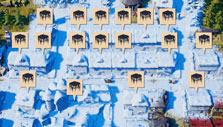
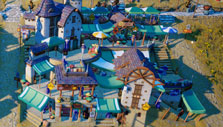 Read More
Read More
Featured Games
 Realm of Warriors
Assemble a party of the strongest heroes to take on both the rebel forces and the corrupting influence of the Dragon Demon in this Chinese-themed browser MMORPG, Realm of Warriors!
Realm of Warriors
Assemble a party of the strongest heroes to take on both the rebel forces and the corrupting influence of the Dragon Demon in this Chinese-themed browser MMORPG, Realm of Warriors!
 RAID: Shadow Legends
Recruit the best to join your team and take on Siroth, the Lord of Darkness himself!
RAID: Shadow Legends
Recruit the best to join your team and take on Siroth, the Lord of Darkness himself!
 Hustle Castle
Save the king and his daughter from the abyssal lord as he threatens to destroy your kingdom and marry your bride to be in this fun mmo simulation game.
Hustle Castle
Save the king and his daughter from the abyssal lord as he threatens to destroy your kingdom and marry your bride to be in this fun mmo simulation game.
 Dark Genesis
Play Dark Genesis and save the world from destruction with your allies.
Dark Genesis
Play Dark Genesis and save the world from destruction with your allies.
 War Robots
Head into the cockpit of a mech and decimate opponents in War Robots.
War Robots
Head into the cockpit of a mech and decimate opponents in War Robots.
 Blade of Kings
Blade of Kings is an idle RPG by Esprit Games. You’ll take a role of a warrior, defending the land from hordes of monsters and attempting to rise in rank in the kingdom. Take part in action-packed idle battles, use a variety of skills, raise pets, and achieve victory.
Blade of Kings
Blade of Kings is an idle RPG by Esprit Games. You’ll take a role of a warrior, defending the land from hordes of monsters and attempting to rise in rank in the kingdom. Take part in action-packed idle battles, use a variety of skills, raise pets, and achieve victory.








